Introduction
The human eye is a highly sophisticated sense organ that allows us to see the world in all its beauty and colors. It is one of the most important organs for perceiving the environment, as it can detect light, colors, shapes, distances, and movements. The structure of the eye is complex, and understanding how it works helps us appreciate how various optical phenomena occur.
Structure of the Human Eye
The human eye is like a camera. It has lenses, an aperture, and a light-sensitive screen, but all of these parts work biologically. Let’s break down the parts of the eye:
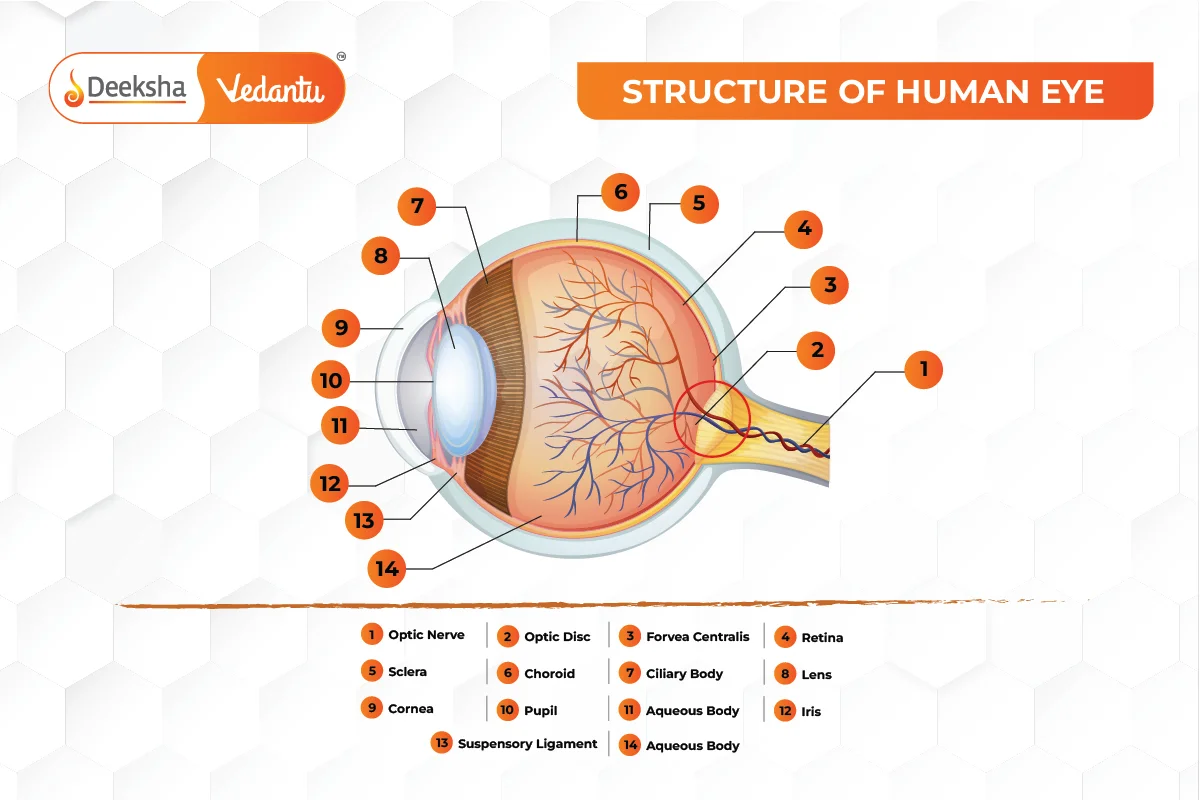
- Cornea: The transparent, outermost layer that covers the front part of the eye. It is responsible for most of the refraction of light entering the eye.
- Iris: The colored part of the eye that controls the size of the pupil by adjusting the amount of light that enters the eye.
- Pupil: The dark, circular opening in the center of the iris that allows light to enter the eye. It expands or contracts depending on the light intensity.
- Lens: A transparent, biconvex structure located behind the iris, which further refracts light to focus it onto the retina. The lens is flexible, allowing it to change shape to focus on objects at different distances.
- Retina: A light-sensitive layer at the back of the eye where the image is formed. It contains millions of photoreceptor cells (rods and cones) that convert light into electrical signals.
- Optic Nerve: It transmits the electrical signals from the retina to the brain, where they are interpreted as visual images.
How Does the Eye Work?

- Light enters the eye through the cornea and is refracted.
- It then passes through the pupil, which controls the amount of light entering the eye.
- The lens further refracts the light, focusing it onto the retina.
- The light-sensitive cells in the retina (rods and cones) detect the light and convert it into electrical signals.
- These signals travel through the optic nerve to the brain, where they are interpreted as the images we see.
Power of Accommodation
The accommodation of the eye is its ability to adjust the focal length of the lens to focus on objects at varying distances. The ciliary muscles in the eye control this process. When these muscles contract or relax, they change the shape of the lens, allowing it to focus light from objects that are far away or close.
Mechanism of Accommodation
- For distant objects: The ciliary muscles relax, causing the lens to become thinner and less curved. This increases the focal length, allowing distant objects to be focused on the retina.
- For nearby objects: The ciliary muscles contract, making the lens thicker and more curved. This decreases the focal length, allowing nearby objects to be focused on the retina.
Limits of Accommodation
- The near point of the eye is the closest distance at which an object can be seen clearly without strain. For a normal adult eye, this is about 25 cm.
- The far point of the eye is the farthest distance at which an object can be seen clearly. For a normal eye, the far point is at infinity.
Example: When reading a book, the ciliary muscles contract to make the lens thicker, enabling you to see the words clearly. When you look at a distant tree, the muscles relax, making the lens thinner to focus on the tree.
Defects of Vision and Their Correction
Despite the eye’s remarkable ability to adjust its focus, some people experience vision problems, which occur when the light entering the eye is not focused properly on the retina. These refractive defects can be corrected using external lenses, such as glasses or contact lenses.
Myopia (Near-Sightedness)
Myopia, or near-sightedness, is a defect in which a person can see nearby objects clearly but finds it difficult to see distant objects. In a myopic eye, light from distant objects is focused in front of the retina instead of on it.
Causes of Myopia:
- Excessive curvature of the cornea or lens.
- Elongation of the eyeball.
Correction of Myopia:
- Myopia can be corrected by using concave lenses, which diverge the light rays entering the eye, allowing them to focus correctly on the retina.
Key Formula: The power of the concave lens required to correct myopia is given by:
Where:
= power of the lens in dioptres,
= focal length in meters (negative for concave lenses).
Example: A person with a myopic eye has a far point of 2 meters. The power of the concave lens required is:
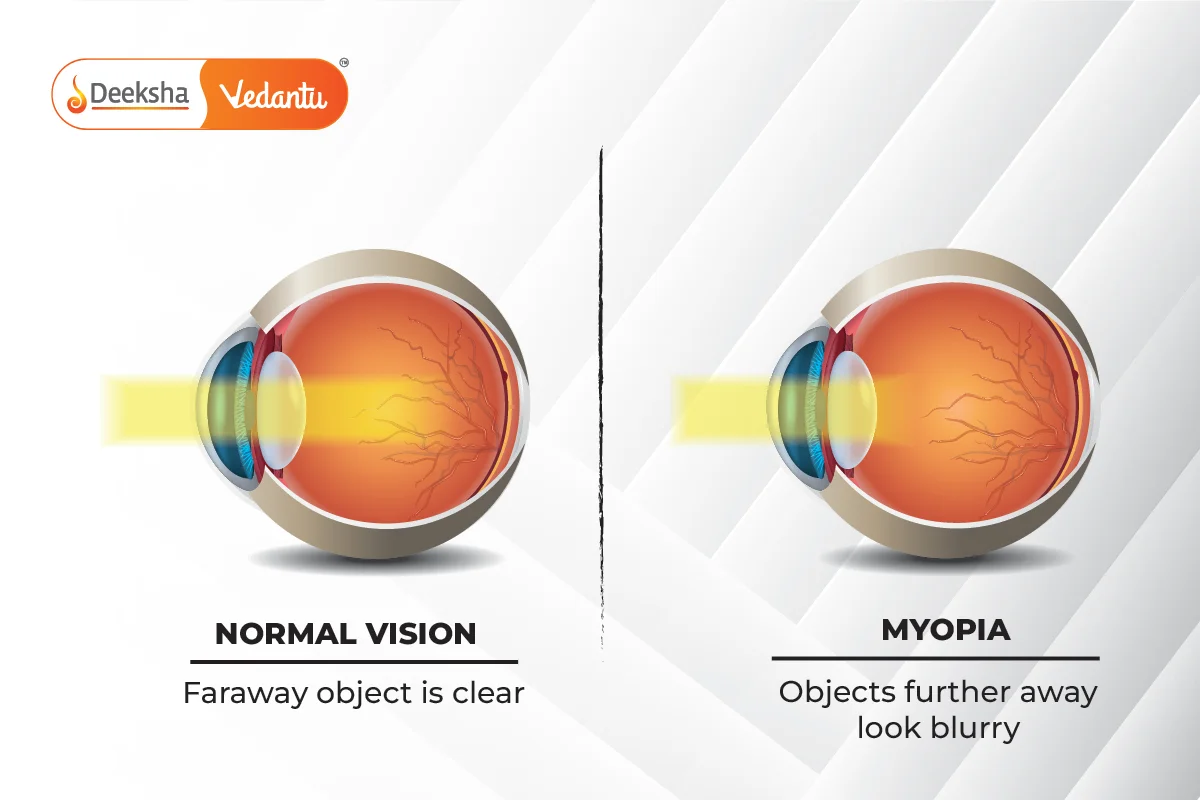
Hypermetropia (Far-Sightedness)
Hypermetropia, or far-sightedness, is a condition in which a person can see distant objects clearly but finds it difficult to focus on nearby objects. In a hypermetropic eye, light from nearby objects is focused behind the retina.
Causes of Hypermetropia:
- The eyeball is too short.
- The lens is too flat or has insufficient curvature.
Correction of Hypermetropia:
- Hypermetropia is corrected by using convex lenses, which converge light rays before they enter the eye, enabling them to focus properly on the retina.
Key Formula: The power of the convex lens required is given by:
Where:
= power of the lens in dioptres,
= focal length in meters (negative for concave lenses).
Example: A person has a near point of 50 cm. The power of the convex lens required is:
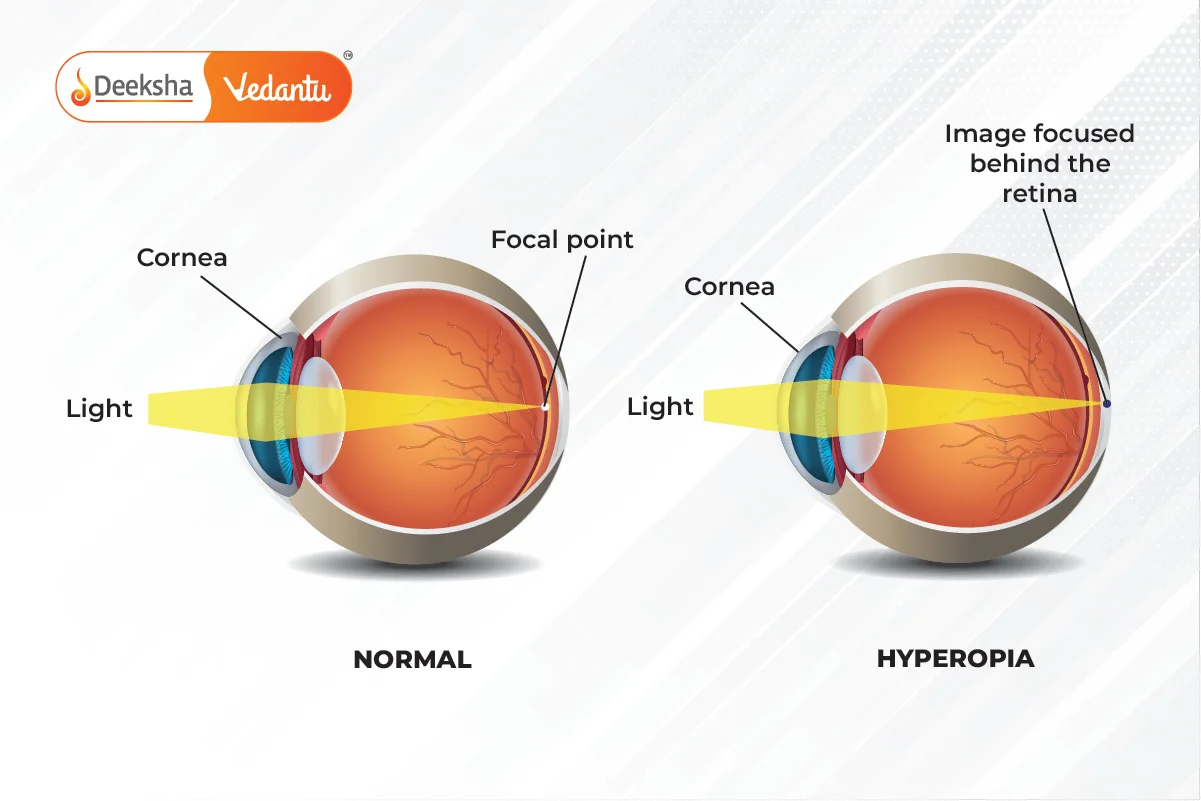
Presbyopia
Presbyopia is an age-related defect of vision. It occurs when the eye’s lens loses its flexibility, making it difficult to focus on nearby objects. As people age, the power of accommodation decreases, and objects close to the eye become blurry.
Causes of Presbyopia:
- Gradual weakening of the ciliary muscles.
- Reduced elasticity of the eye lens.
Correction of Presbyopia:
- Presbyopia is often corrected using bifocal lenses, which contain both concave and convex lenses. The upper part of the lens helps in viewing distant objects, while the lower part helps in viewing nearby objects.
Example: A person may require bifocal lenses if they suffer from both myopia and hypermetropia. These lenses have two distinct parts: one for distance vision and one for reading.
Refraction of Light Through a Prism
When light passes through a prism, it undergoes refraction twice: once when it enters the prism and again when it exits. The shape of the prism causes the light to bend at an angle, resulting in the dispersion of white light into its constituent colors.
Key Concepts:
- A prism has two triangular bases and three rectangular lateral surfaces. Light entering the prism refracts and bends toward the base of the prism.
- The degree of bending depends on the wavelength of the light, with shorter wavelengths bending more than longer ones.
Angle of Deviation:
The angle between the incident ray and the emergent ray is called the angle of deviation. The degree of deviation depends on the refractive index of the material of the prism and the wavelength of the light.
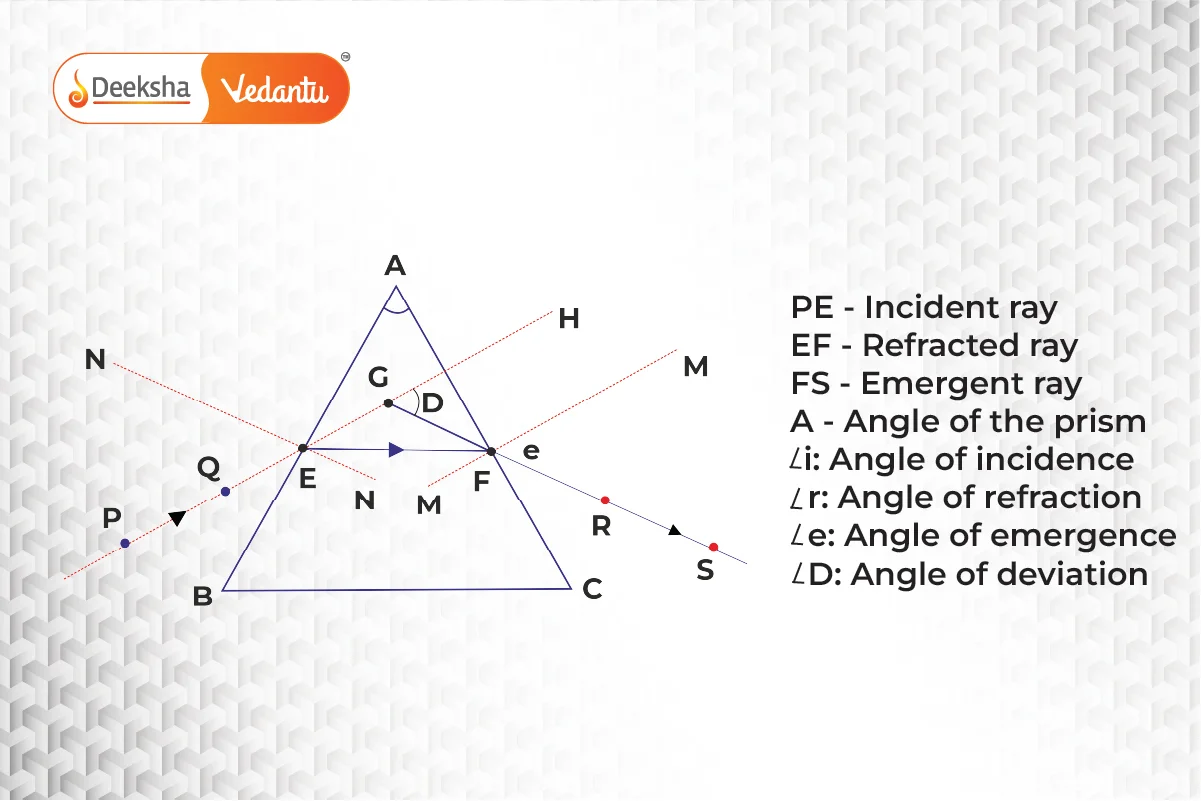
Dispersion of White Light
Dispersion is the phenomenon in which white light splits into its component colors when it passes through a medium like a prism. This happens because different colors of light have different wavelengths, and each wavelength bends by a different amount as it passes through the prism.
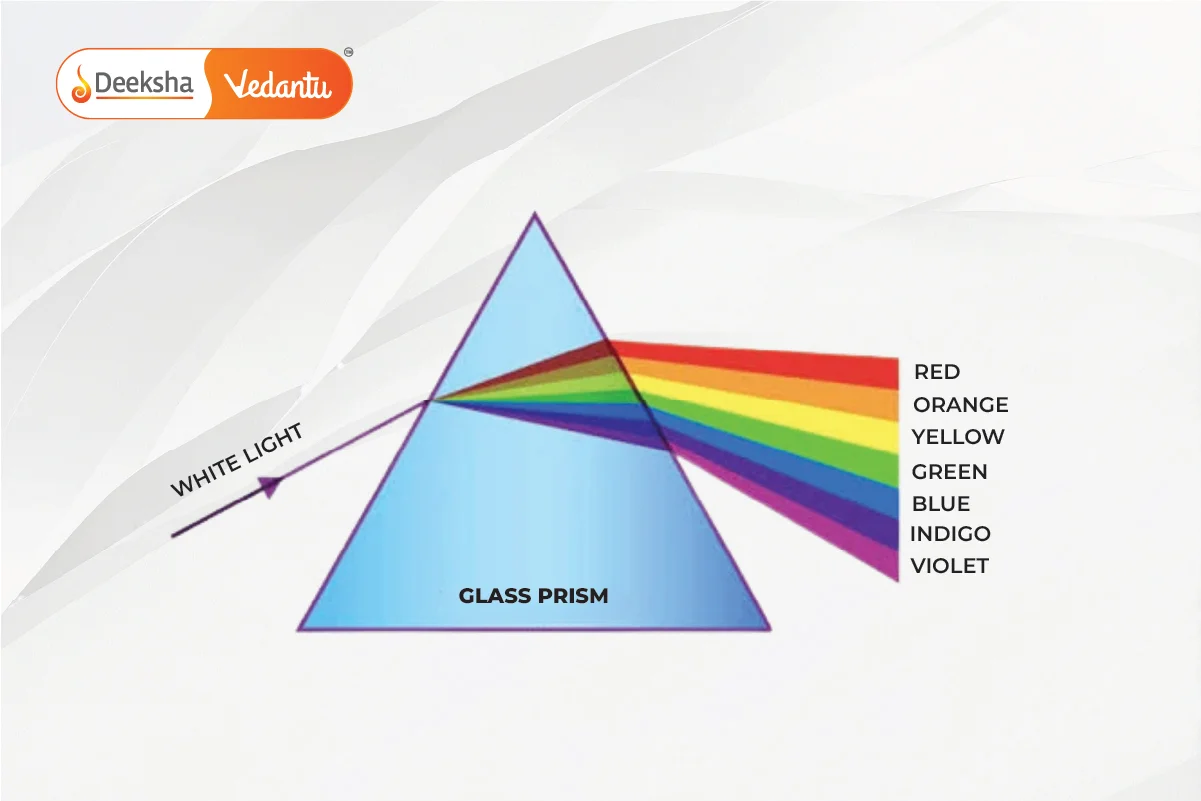
Key Points:
- Violet light, with the shortest wavelength, bends the most.
- Red light, with the longest wavelength, bends the least.
The splitting of light into its component colors forms a spectrum. This can be seen when light passes through a glass prism, creating the visible spectrum, often remembered as VIBGYOR (Violet, Indigo, Blue, Green, Yellow, Orange, Red).
Example:
- The rainbow is a natural example of dispersion. Sunlight enters raindrops in the atmosphere, gets refracted, and is dispersed into its component colors, forming a beautiful spectrum.
Atmospheric Refraction
Atmospheric refraction occurs when light passes through the Earth’s atmosphere, which consists of layers of air with varying temperatures and densities. This results in the bending of light, leading to several optical phenomena, such as the twinkling of stars and the advanced sunrise and delayed sunset.
Twinkling of Stars
- Stars appear to twinkle because their light passes through different layers of the atmosphere with varying densities. This causes the light to refract differently as it moves through the atmosphere, making the star appear to flicker.
Advanced Sunrise and Delayed Sunset
- Due to atmospheric refraction, the Sun appears to rise earlier and set later than it actually does. This is because the light from the Sun bends as it passes through the atmosphere, allowing us to see the Sun even when it is below the horizon.
Scattering of Light
Scattering of light is a phenomenon where light is deflected in various directions as it passes through particles in the atmosphere. The amount of scattering depends on the wavelength of light and the size of the particles.
Why is the Sky Blue?
- The sky appears blue because shorter wavelengths of light, such as blue, scatter more than longer wavelengths, such as red, when sunlight passes through the Earth’s atmosphere. This scattered blue light reaches our eyes, making the sky appear blue.
Reddening of the Sun
- During sunrise and sunset, sunlight has to travel through a thicker layer of the atmosphere, causing most of the blue and violet light to scatter out of view. As a result, the longer-wavelength red and orange light remains, making the Sun appear reddish.
Practice Questions with Answers
Q1: What is meant by the power of accommodation of the eye?
- Answer: The power of accommodation refers to the eye’s ability to adjust the focal length of the lens to focus on objects at different distances.
Q2: Explain why myopia occurs and how it can be corrected.
- Answer: Myopia occurs when the eye’s lens is too curved or the eyeball is too long, causing light to focus in front of the retina. It is corrected by using concave lenses, which diverge light before it enters the eye, allowing it to focus on the retina.
Q3: Why do stars twinkle?
- Answer: Stars twinkle due to atmospheric refraction. As the light from a star passes through layers of the Earth’s atmosphere, it is refracted in different directions, causing the star’s brightness and position to appear to fluctuate.
Q4: How does the dispersion of light lead to the formation of a rainbow?
- Answer: A rainbow forms when sunlight enters raindrops in the atmosphere, is refracted, and then dispersed into its component colors. Each color bends by a different amount, creating a spectrum of colors in the sky.
Q5: Why does the sky appear blue during the day and reddish during sunrise and sunset?
- Answer: The sky appears blue during the day due to the scattering of shorter wavelengths of light (blue) by the molecules in the atmosphere. During sunrise and sunset, the light has to travel through more atmosphere, scattering the blue light and leaving the longer-wavelength red light.
FAQs
Planets do not twinkle because they are much closer to Earth and appear as extended sources of light, not point sources like stars. The variations in light from different parts of the planet cancel out, so the planet appears steady.
Presbyopia is caused by the gradual weakening of the ciliary muscles and the reduced elasticity of the lens, making it difficult to focus on nearby objects. It is corrected using bifocal or progressive lenses.
The near point is the closest distance at which an object can be seen clearly, typically about 25 cm for a normal adult. The far point is the farthest distance at which objects can be seen clearly, which is at infinity for a normal eye.
Related Topics
- Magnetic Field And Field Lines
- Zener Diode
- Force On A Current – Carrying Conductor In A Magnetic Field
- Scattering Of Light
- List of Physics Scientists and Their Inventions
- Electricity
- Protection Against Earthquake
- Ohm’s Law
- Heating Effect Of Electric Current
- Electric Potential And Potential Difference
- Compound Microscope
- Full Wave Rectifier
- The Human Eye
- Electric Current And Circuit
- Mirrors











Get Social